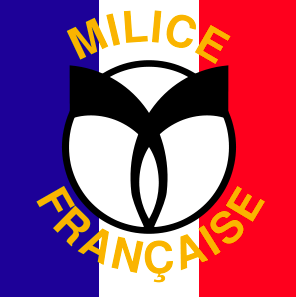
Why did the French government collaborate with the Germans during the four years of occupation? Why did the politicians carry out and many times exceed the German directives and expectations (especially for the deportations of Jews)? Why did French organizations form to terrorize their own citizens? Finally, why did individual French citizens denounce their fellow countrymen and women knowing full well the victims would likely not survive?
These are very complicated questions with no simple answers.
Two of the most feared collabo (collaborationist) French organizations were La Carlingue and the Milice.
The Bonny-Lafont Gang
93 rue Lauriston, Paris
Formally known as La Carlingue or the French Gestapo, this group of criminals was better known to the Parisians as the Bonny-Lafont Gang. The Nazis called them Active Group Hesse (after the Gestapo SD officer placed in the gang), Lauristondienst (Lauriston Service), the Gestapo française, or Bande de la Rue Lauriston.
After the Gestapo established itself in Paris, they formed two special units: the Intervention-Referat (teams of killers to do the jobs the Gestapo didn’t want to be identified with) and a unit of Frenchmen for training auxiliary agents. Members of these units were primarily convicted criminals purposely released from prison. One of the principal recruiters was a career criminal who could not read or write: Henri Chamberlin aka Henri Lafont (1902–1944).
Henri Lafont
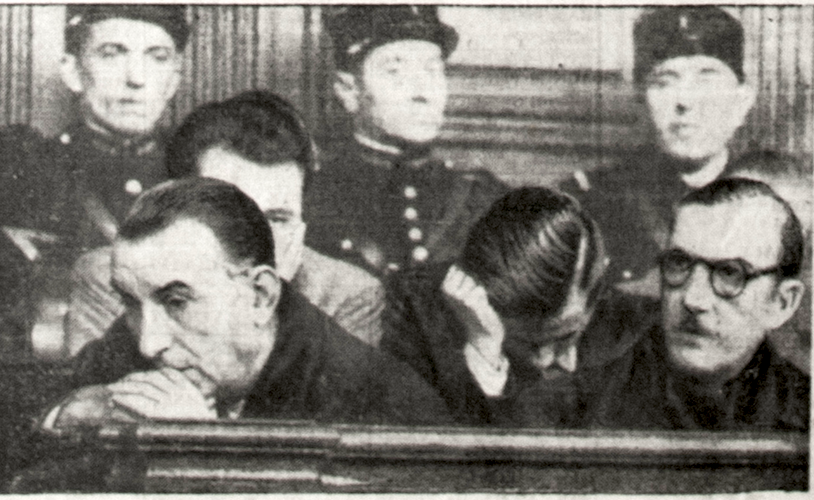
Lafont began to work for the Abwehr (German military intelligence) in 1940 after being introduced to them by an Abwehr informer: Max Stocklin. One of Lafont’s first assignments was taking the possessions of displaced Jews and turning it over to Stocklin and the Bureau Otto (the Black Market). By 1942, he had teamed up with the Gestapo and his new partner, Pierre Bonny (1895–1944). Together, they created La Carlingue. The black market substantially dried up in 1943 and the Bonny-Lafont gang began its vicious activities by assisting the Gestapo in hunting down résistants (members of the French Resistance) as well as the Maquisards (members of a large resistance group operating in both the occupied and unoccupied zones). It also continued its activities in the downsized Black Market as well as establishing a significant support system of informants, corrupt officials, and less than reputable business leaders.
By 1942, Lafont had become a German citizen and a captain in the SS and Gestapo and within two years, members of the Bonny-Lafont gang began to publically wear German uniforms. Most of the French citizens feared this organization and The Milice, a paramilitary French organization, more than they did the Gestapo and its agents. These members were Frenchmen, knew the various French dialects, and were familiar with French customs, practices, and the landscape—attributes most Germans did not possess. Infiltration by these organizations into the resistance networks was very easy. No one knew who was a friend or a foe.
Pierre Bonny
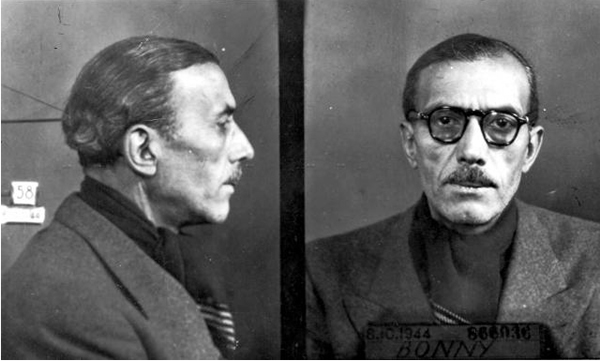
Bonny was a well-known and respected former police inspector who was brought up on corruption charges in 1934. He was tried, convicted, and sentenced to three years imprisonment. After his release from prison, Bonny started a private detective agency specializing in following supposed unfaithful wives.
Once Bonny was recruited, the gang began to show signs of an organized structure and administrative discipline. It was now Bonny’s turn to begin to recruit new members from the prisons with the assistance of the Gestapo.
As a side note, the summer of 1942 saw Pierre Bonny put in charge of investigating an escape organization run by a “Dr. Eugène.” After three gang members passed themselves off as persons willing to pay 50,000 francs apiece for an exit out of Occupied France, Bonny and others followed Dr. Eugène to his house on Rue le Sueur and “arrested” him. The doctor was none other than the notorious serial killer, Dr. Marcel Petiot and they were in his killing house. He was released and allowed to continue his killing with Lafont taking a cut of the action. We will visit the house in our new book Where Did They Put the Gestapo Headquarters? but if you’d like a preview of the good doctor’s story, visit our prior blog entitled Jacques the Ripper.
Arrests, Interrogations, and Executions
The three story building at 93 rue Lauriston (16e) was occupied by La Carlingue. The group also occupied a building at 3 bis, Place des Etats-Unis (16e) whose floors were converted into cells and interrogation (read: torture) rooms. At 93 rue Lauriston, Lafont’s offices on the second floor were lined with steel. The former servants quarters on the third floor were turned into cells. Similar to Gestapo offices located on Avenue Foch (No. 84 in particular), neighbors could hear the screams of prisoners during the night. The torture chambers on the third floor and an execution room in the basement became infamous during the Occupation and even today, memories of the building’s brutal legacy remain.
Arrest, Trial, and Sentence
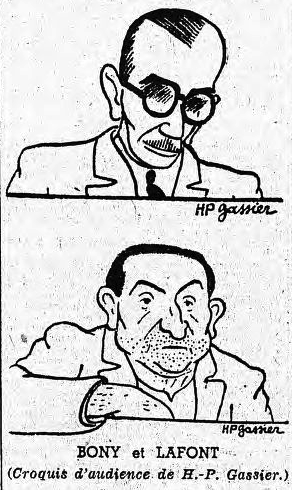
The liberation of Paris and France brought the operations of Lafont and Bonny to an end. They and most of the members of the gang were very well known throughout Paris having lived a very lavish life style during the preceding four years. The leaders knew the penalty for being high profile and extremely vicious collabos.
On 30 November 1944, Bonny and Lafont along with several other high level members were caught hiding on a farm southeast of Paris. The farm was suspected of being a “French ODESSA” used by the Gestapo to get its men out of France. At the arrest, authorities found a fraction of Lafont’s ill-gotten gains: ten million francs and jewelry. His white Bentley was not located.
Henri Lafont, Pierre Bonny, and five members were put on trial less than two weeks after their arrest. Learn more. During the trial, the sordid details of their activities were divulged including the bath tub torture, the basement execution chamber, the accumulated wealth, and most damaging to the French government, Lafont’s close relationship with Pierre Laval, the prime minister of the Vichy government.
Fourteen days later on 27 December 1944, the seven men were executed by firing squad.
“De-Christening” History and Memories
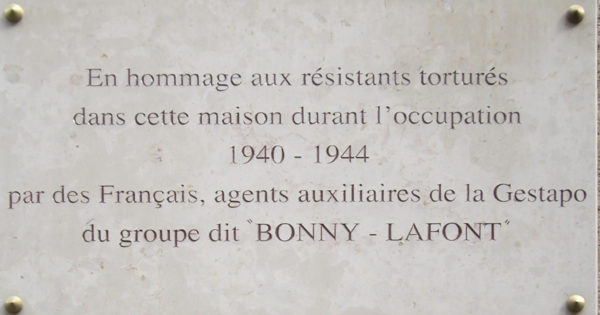
In 2009, the mayor of the 16th arrondissement (16e district) decided he wanted to change the address of La Carlingue’s former headquarters to 91 bis rue Lauriston. His purpose was to erase the building’s “monstrous past:” the tenant (Franco-Arab Chamber of Commerce) had threatened to move unless the address was changed.
Former members of various French resistance networks complained loudly. As one said, “How could they even consider it?” The Le Parisien newspaper wrote, “The people who want to de-christen it are wrong: changing a number doesn’t rub out the past.”
The address remains the same and one thing the mayor never suggested erasing was the name used by many Parisians to describe Rue Lauriston: The Street of Horrors.
The Franco-Arab Chamber of Commerce is now in a new location in Paris.
What’s New With Sandy and Stew?
We are very excited about the next blog (to be published on April 1, 2017). It will be a guest blog written by Sarah Murden and Joanne Major. Sarah and Jo are historians focusing on the Georgian Era in England and are the co-authors of An Infamous Mistriess: The Life, Loves and Family of the Celebrated Grace Dalrymple Elliott. Their new book, A Right Royal Scandal, has just been published.
You were introduced to Grace in our blog Grace Under Fire. Sarah and Jo’s blog touches on Grace and a behind the scenes description of their research.
I hope you enjoy their books and the new blog as much as I have.
Someone Is Commenting On Our Blogs
If there is a topic you’d like to see a blog written about, please don’t hesitate to contact me. I love hearing from you so keep those comments coming.
Why Would You Want To Buy Our “Walks Through History” Books?
Simple.
You like to travel and experience history and historical events. You like to see original buildings that had a significant impact on the people and events of the history you’re engaged with. You want to know the stories behind the brick and mortar in front of you.
The walking tour books are meticulously researched so you can go directly to those sites and learn about the building’s history as well as an introduction to some of the more interesting people associated with it.
Thank You
Sandy and I appreciate you visiting with us. We have some exciting things on the horizon and we’ll keep you updated as we go along.
Share This:
Follow Stew:
Find Stew’s books on Amazon and iBooks.
Please note that we do not and will not take compensation from individuals or companies mentioned or promoted in the blogs.
Walks Through History
Copyright © 2017 Stew Ross



Very interesting since I was born rue Lauriston on June 4, 1943.
There was a clinic next to the Gestapo office and since my parents lived in the 16th district, that is where I happened to be born. Interestingly enough, my Mom’s doctor who recommended the clinic was Jewish. My Mom stayed there a few days (unlike like today where you get to come home right after birth) and she told me that she could hear a lot of traffic going on in that street (car doors and a lot of shouting).
I have been living in the United States for 50 yrs and still go “home” every year. This part of history was told to me by my Mom and all the things they went through at that time. My birth place is special in a way being so close to something so notoriously horrific.
Thank you Nicole for your comments regarding Rue Lauriston. I’ll bet your Mother shared many stories with you about the German Occupation. Please stay in touch as I would very much like to hear more of those stories and perhaps, share them with our readers. STEW